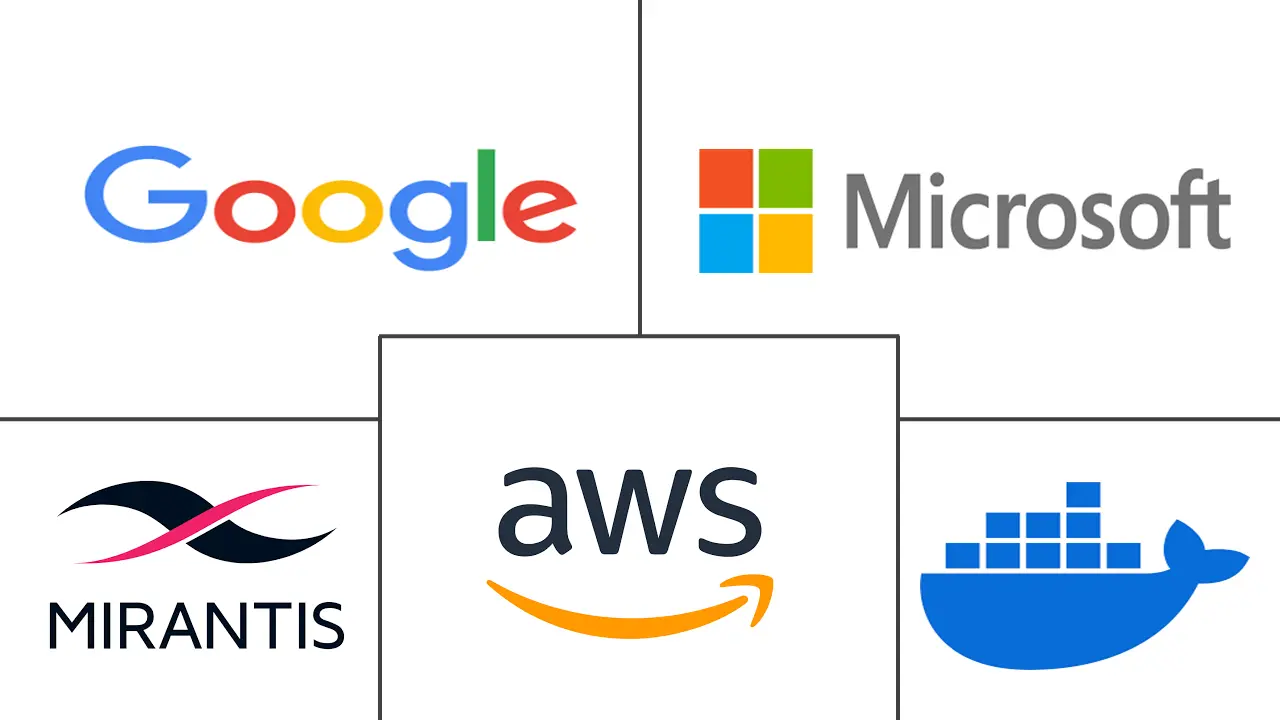Application Container Market Size and Share
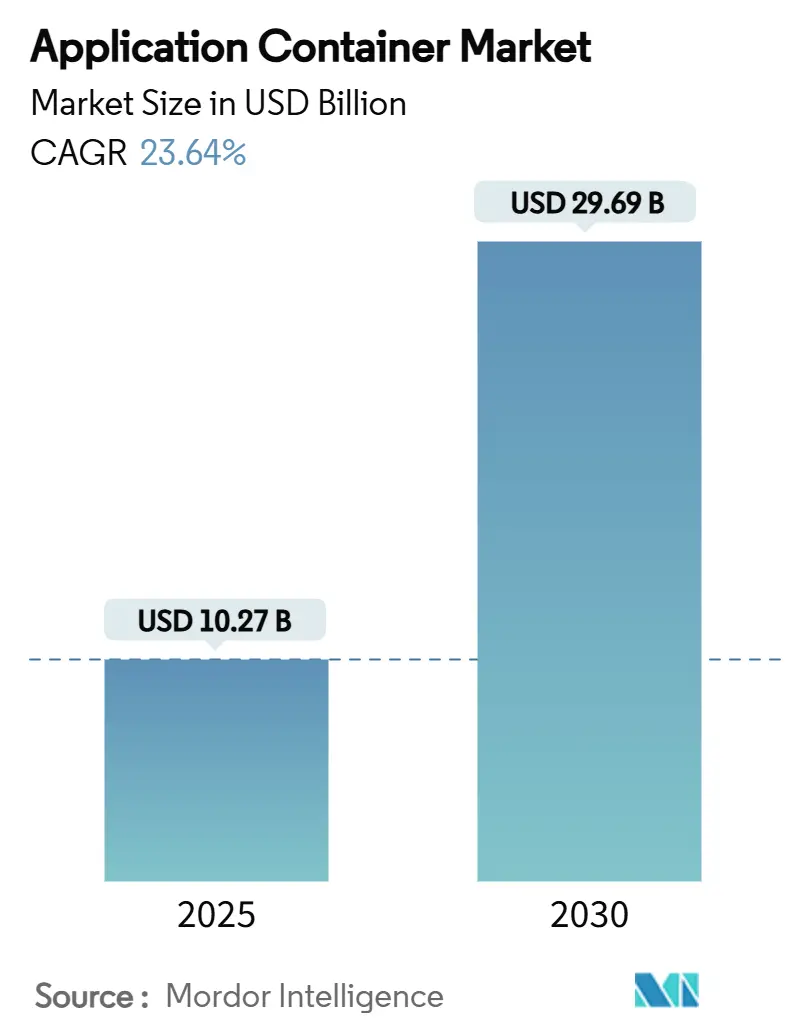
Application Container Market Analysis by Mordor Intelligence
The global application container market size stood at USD 10.27 billion in 2025 and is forecast to climb to USD 29.69 billion by 2030, advancing at a 23.64% CAGR. Strong enterprise migration toward micro-services, the proliferation of DevOps pipelines and the growing preference for hybrid, multi-cloud architectures are sustaining this momentum. Platform solutions accounted for 57.1% revenue in 2024, reflecting the central role of Kubernetes-based orchestration, yet services are expanding faster at an 18.20% CAGR as organizations seek implementation, migration, and managed expertise [1]Red Hat, “2024 Global Tech Trends,” redhat.com. Public-cloud deployments led with 64.3% share, but hybrid and multi-cloud setups are the fastest risers at 24.50% CAGR, driven by workload portability and compliance demands. Large enterprises retained a 68.2% share, although small and medium enterprises are scaling adoption at a 21.30% CAGR as managed container offerings lower entry barriers. Industry uptake remains highest in IT and telecom (35.8% share), while healthcare shows the strongest vertical upside at 19.70% CAGR, propelled by digital health mandates and stringent data-privacy regulations.
Key Report Takeaways
- By component, platform solutions captured 57.1% of the application container market share in 2024; services are forecast to grow at an 18.20% CAGR to 2030.
- By deployment model, public cloud held 64.3% of the application container market size in 2024, whereas hybrid and multi-cloud configurations are progressing at a 24.50% CAGR through 2030.
- By organization size, large enterprises commanded 68.2% revenue share in 2024; small and medium enterprises are set to expand at a 21.30% CAGR over the same horizon.
- By vertical, IT and telecom contributed 35.8% turnover in 2024, while healthcare is advancing at a 19.70% CAGR to 2030.
- By use-case area, management and orchestration represented 37.9% of implementations in 2024, and security solutions are pacing the field at a 23.40% CAGR during the outlook period.
- By geography, North America generated 44.1% sales in 2024; Asia-Pacific is charting the fastest route with a 22.80% CAGR to 2030.
Global Application Container Market Trends and Insights
Drivers Impact Analysis
| Driver | (~) % Impact on CAGR Forecast | Geographic Relevance | Impact Timeline |
|---|---|---|---|
| Accelerating adoption of micro-services | +6.2% | North America, Europe, expanding globally | Medium term (2-4 years) |
| Demand for hybrid and multi-cloud agility | +5.8% | APAC, Europe, global enterprises | Long term (≥ 4 years) |
| Surge in DevOps and CI/CD pipelines | +4.9% | North America, Europe, APAC followers | Short term (≤ 2 years) |
| Need for resource optimization and cost cut | +3.7% | Worldwide, accentuated in cost-sensitive markets | Medium term (2-4 years) |
| Edge-native AI workloads | +2.1% | APAC lead, spillover to North America | Long term (≥ 4 years) |
| Arm-based servers enhancing performance | +1.1% | Global hyperscalers and telcos | Long term (≥ 4 years) |
| Source: Mordor Intelligence | |||
Accelerating Adoption of Micro-services Architecture
Container penetration reached 88% among surveyed technology leaders in 2025, with micro-services framed as the principal catalyst [2]Veeam, “Enterprise Kubernetes Report,” veeam.com. Deutsche Bank’s centralized platform runs more than 3,100 active projects and cut release cycles from six months to three weeks once workloads were containerized. Decoupling monoliths into independently deployable services enables elastic scaling and streamlined incident isolation, illustrated by financial institutions such as Bank Mandiri, whose digital banking backbone now processes 12,000 requests per second while sustaining 99.95% uptime. The architectural shift has also unlocked continuous delivery patterns that align development sprints with business imperatives. As a result, enterprises view micro-services not merely as a development paradigm but as a strategic lever for time-to-market acceleration.
Demand for Hybrid and Multi-Cloud Agility
Seventy-six percent of organizations operated two or more public clouds in 2024, citing vendor lock-in avoidance and regulatory flexibility as top rationales. Banco Galicia consolidated disparate workloads across on-premises and multiple public clouds, realizing a 40% downtime reduction after adopting a unified Kubernetes control plane. Service-mesh overlays now route east-west traffic securely among clusters residing in different regions, providing uniform policy enforcement regardless of underlying provider. Infrastructure-as-Code practices further standardize provisioning, allowing enterprises to shift workloads in response to price, latency or governance triggers without refactoring code. The resulting operational agility propels the application container market as organizations future-proof application estates against evolving compliance and performance constraints.
Surge in DevOps and CI/CD Pipelines
Eighty-four percent of container users report smoother deployment workflows once containers underpin continuous integration and delivery stages. Credit Europe Bank compressed customer-onboarding cycle time from two weeks to 15 minutes after embedding container images into automated pipelines orchestrated by OpenShift GitOps. Containers supply a consistent runtime image from laptop to production cluster, enabling repeatable builds and rollback safety. Automated unit tests and security scans integrated into pipelines catch defects early, driving higher release velocity without sacrificing quality. The cultural impact is equally pronounced: cross-functional squads gain shared accountability for code and infrastructure, reinforcing the DevOps ethos.
Need for Resource Optimization and Cost Efficiency
Red Hat OpenShift deployments delivered a documented five-year ROI of 531% and annual savings of USD 1.29 million per 100 developers through higher compute utilization and reduced management overhead. Ring Container Technologies reclaimed more than 12,000 labor-hours annually after pairing containerized workflows with AI-driven automation, trimming inventory reconciliation from one day to minutes and saving USD 75,000 each year. Autoscaling and bin-packing algorithms squeeze unused CPU cycles, while spot-market purchasing aligns compute spend with demand curves. These gains resonate most in cost-sensitive industries, positioning container technology as both an innovation enabler and a financial efficiency tool for the application container market.
Restraint Impact Analysis
| Restraint | (~) % Impact on CAGR Forecast | Geographic Relevance | Impact Timeline |
|---|---|---|---|
| Container security vulnerabilities | –3.2% | Regulated industries worldwide | Short term (≤ 2 years) |
| Complexity of large-scale orchestration | –2.8% | Hybrid and multi-cloud adopters | Medium term (2-4 years) |
| Open-source license-compliance uncertainty | –1.4% | Europe, North America | Long term (≥ 4 years) |
| Data-sovereignty limits on cross-border use | –1.1% | Europe, APAC | Long term (≥ 4 years) |
| Source: Mordor Intelligence | |||
Container Security Vulnerabilities and Misconfigurations
Containers harbor more than 600 disclosed vulnerabilities on average, and 97% of surveyed teams voice concerns about Kubernetes security posture. Misconfigurations top the risk list, prompting Gartner to forecast that 99% of cloud breaches will stem from customer error rather than provider flaws by 2026. A recent NVIDIA Container Toolkit flaw (CVE-2024-0132, CVSS 9.0) illustrated potential host-escape vectors that threaten multi-tenant clusters. Enterprises respond by integrating image scanning, runtime monitoring, and zero-trust network policies, yet skills gaps and tool sprawl complicate remediation. Until organizations harden pipelines end-to-end, security fears will temper the CAGR of the application container market.
Complexity of Large-Scale Orchestration
Sixty percent of enterprises cite performance-tuning headaches, and 44% wrestle with policy enforcement when running multi-cluster Kubernetes fleets. Spectro Cloud’s field data shows identity-access controls and network segmentation as recurrent pain points in hybrid deployments. Steep learning curves challenge talent pipelines, elevating the cost of skilled site reliability engineers. Vendors counter with opinionated platforms that automate lifecycle tasks, but heterogeneity across providers still demands custom integration. This operational complexity slows time-to-production and nudges cautious firms toward managed services, affecting near-term expansion of the application container market.
Segment Analysis
By Component: Services Gain Ground
Platform software constituted 57.1% of 2024 revenue as enterprises standardized on Kubernetes distributions such as OpenShift and Tanzu, yet services exhibited an 18.20% CAGR that outpaced every other component. The application container market size for services is projected to swell as firms confront skills shortages and regulatory audits. Consulting and managed engagements accelerate greenfield rollouts while de-risking migrations of legacy workloads into micro-services. The rising complexity of multi-cloud estates further cements long-term demand for integration partners and 24x7 support desks.
Vendor roadmaps now bundle training and FinOps guidance alongside pure technology deliverables. Deutsche Bank’s partnership with Red Hat exemplifies the model: the bank leaned on vendor architects to cut release cycles by two-thirds, proving that knowledge transfer can be as valuable as software licenses. The virtuous loop of tooling plus expertise positions services as the most vibrant profit pool within the application container market over the forecast horizon.
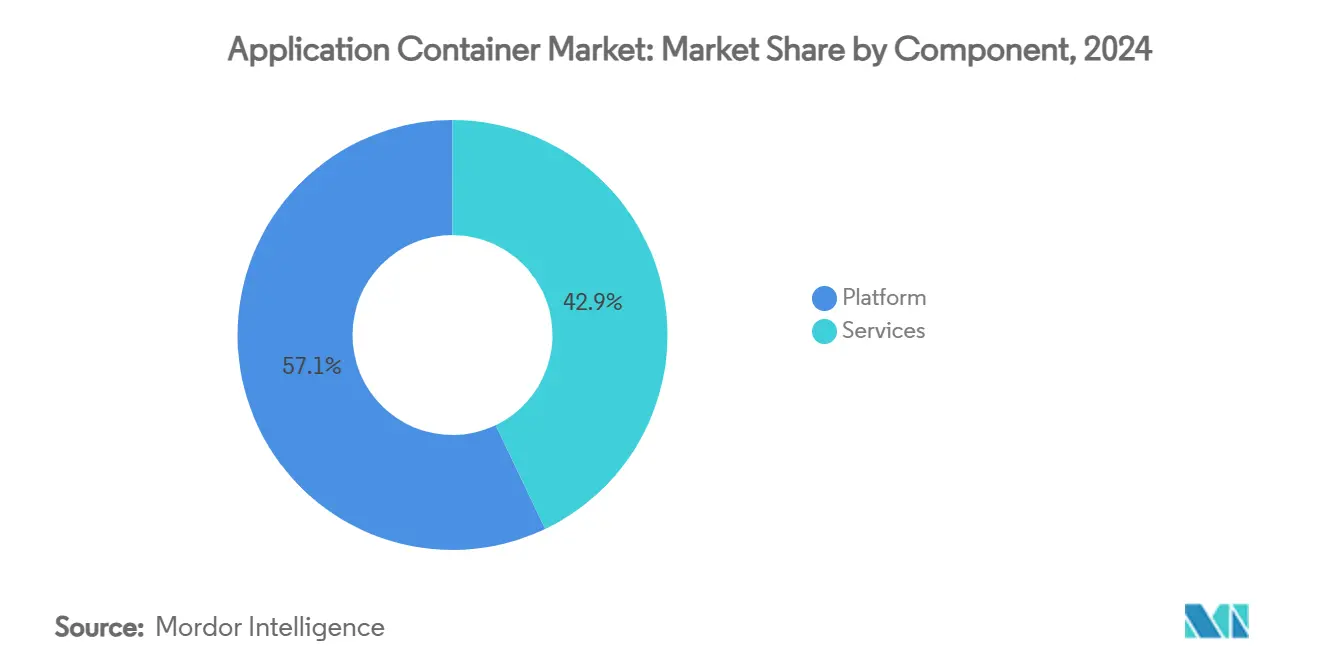
By Deployment Model: Hybrid Scenarios Accelerate
Public cloud captured 64.3% of revenue in 2024, a figure buoyed by the maturity of managed Kubernetes offerings like Amazon EKS, Google GKE, and Azure AKS. However, hybrid and multi-cloud footprints are scaling at a 24.50% CAGR—double the broader application container market—because companies now distribute workloads to optimize latency, sovereignty, and uptime. The application container market share for public cloud may narrow modestly as regulated industries shift critical databases to private regions while keeping stateless micro-services at hyperscale.
Edge gateways, 5G core functions, and AI inference clusters intensify the need for uniform governance spanning bare metal, virtualized stacks, and public IaaS. Banco Galicia’s 40% downtime reduction after adopting a multi-cloud mesh demonstrates the operational upside of unified policy engines. Over the next five years, workload placement decisions will hinge less on raw compute pricing and more on data jurisdiction and sustainability constraints, reinforcing hybrid design patterns across the application container market.
By Organization Size: SME Momentum Builds
Large enterprises generated 68.2% of 2024 turnover on the strength of deep IT budgets, brownfield modernization agendas and strict compliance needs. Most operate dozens of clusters, weaving containers into digital factories, omnichannel banking and SaaS product lines. Yet the fastest growth—21.30% CAGR—belongs to small and medium enterprises, whose migration path increasingly starts with lightweight Kubernetes options such as Red Hat Micro Shift or managed clusters bundled into PaaS subscriptions.
The appeal lies in predictable pricing and a dramatic drop in administration overhead. SMEs avoid the capital expenditure of on-premises infrastructure while still capturing the agile release cadence enjoyed by global peers. As skills marketplaces widen and certified training proliferates, barriers to entry erode. Consequently, the application container market will see a rebalancing in which SMEs convert from proof-of-concept pilots to scaled production, pushing demand downstream into sectors like specialty manufacturing, regional healthcare and direct-to-consumer retail.
By Industry Vertical: Healthcare Surges
IT and telecom retained leadership with 35.8% share in 2024, leveraging containers for network-function virtualization and 5G packet cores that require millisecond responsiveness. However, healthcare is advancing at a 19.70% CAGR, the most rapid rate among tracked sectors. Digital-health platforms such as Siemens Healthineers’ teamplay digital health ecosystem rely on Azure Kubernetes Service to aggregate imaging data and deliver AI insights at the point of care. Strict HIPAA and GDPR rules encourage immutable, auditable container images, transforming compliance from a hurdle to a catalyst.
Pharma research pipelines likewise benefit from container-based high-performance compute grids that compress simulation runtimes. BFSI, manufacturing, and public-sector bodies round out high-adoption cohorts, each drawn by governance, repeatable deployment, and horizontal scale. The application container market will increasingly reflect a mosaic of domain-specific tooling—from FDA-validated pipelines to zero-trust policy packs—that anchor technology choices to vertical mandates.
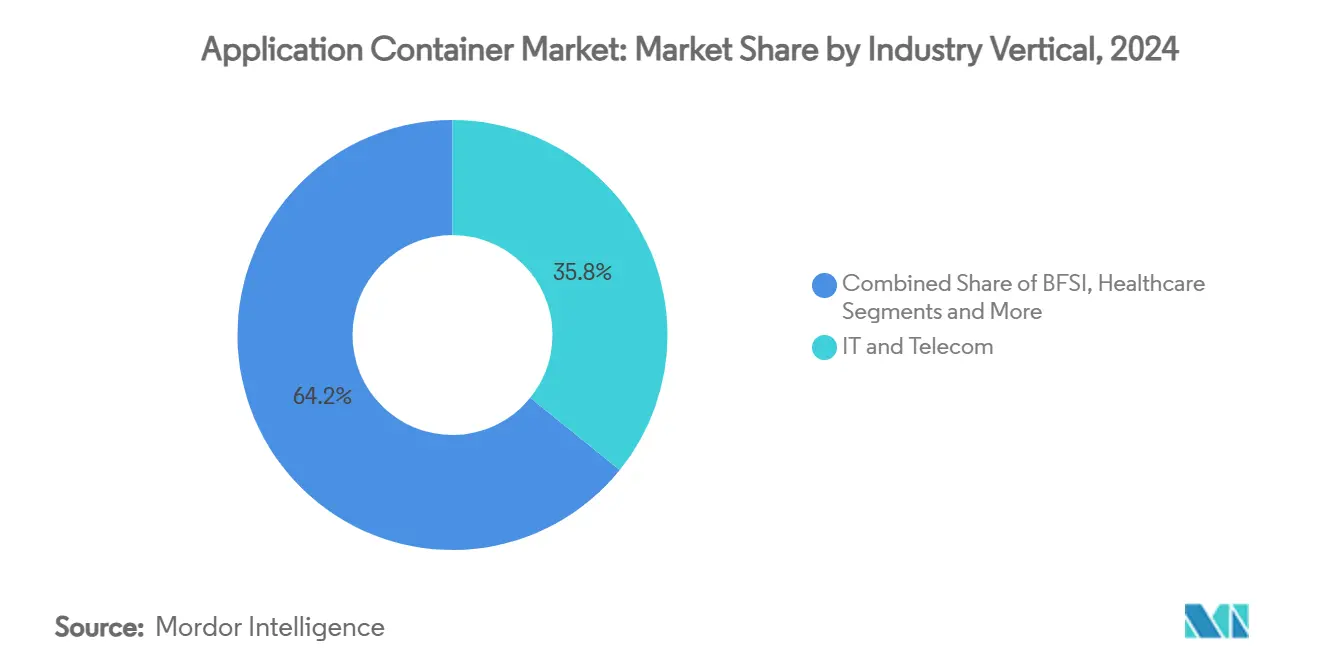
Note: Segment shares of all individual segments available upon report purchase
By Container Use-Case Area: Security Takes Center Stage
Management and orchestration tools held a 37.9% share in 2024 as organizations raced to operationalize Kubernetes clusters at scale. While indispensable, this layer now competes for budget with security solutions growing at a 23.40% CAGR. Runtime protection, vulnerability scanning and policy-as-code modules safeguard clusters from the moment images hit registries to the second workloads terminate. High-severity incidents such as CVE-2024-0132 underscore why chief information security officers treat container defense as board-level priority.
Observability suites also mature, combining OpenTelemetry traces with Prometheus metrics to provide fine-grained insights. Networking plug-ins move toward service-mesh architectures that couple traffic encryption with granular access controls. Storage abstractions, meanwhile, enable stateful sets to inhabit persistent volumes replicated across zones, elevating container applicability to transactional workloads. These innovations, while specialized, all converge to elevate total platform resilience, thereby expanding the addressable universe for the application container market.
Geography Analysis
North America produced 44.1% of 2024 revenue, a testament to entrenched DevOps cultures, abundant venture capital and the dominance of U.S. hyperscalers. Docker’s recent USD 40 million Series C, steered by Sequoia Capital, typifies continued investor confidence. Federal modernization programs and fintech deregulation further spur adoption. Canada’s healthcare digitization push and Mexico’s e-commerce boom extend North America’s container footprint beyond its largest economy.
Asia-Pacific records the steepest growth profile at 22.80% CAGR. Government smart-city grants, surging mobile-commerce volumes, and 5G rollouts stimulate containerized edge infrastructure in China, India, Japan, and South Korea. Singapore’s Infocomm Media Development Authority allocates cloud credits that lower onboarding costs for start-ups, while Australian state agencies pilot Kubernetes-based digital-identity platforms. Collectively these efforts grow the application container market size across APAC faster than any other region.
Europe maintains steady progress underpinned by GDPR, which turns data sovereignty from an obstacle to an enabler for hybrid adoption. Germany’s Industrie 4.0 factories, France’s public-cloud sovereignty initiative, and the United Kingdom’s open-banking benchmarks reinforce demand for policy-aware container stacks. Multi-vendor alliances in Spain and the Netherlands show how mid-tier economies can leapfrog legacy infrastructure by standardizing on cloud-native blueprints. The Middle East and Africa trail but accelerate as energy conglomerates in Saudi Arabia deploy containers for predictive maintenance and South African banks digitize retail channels.
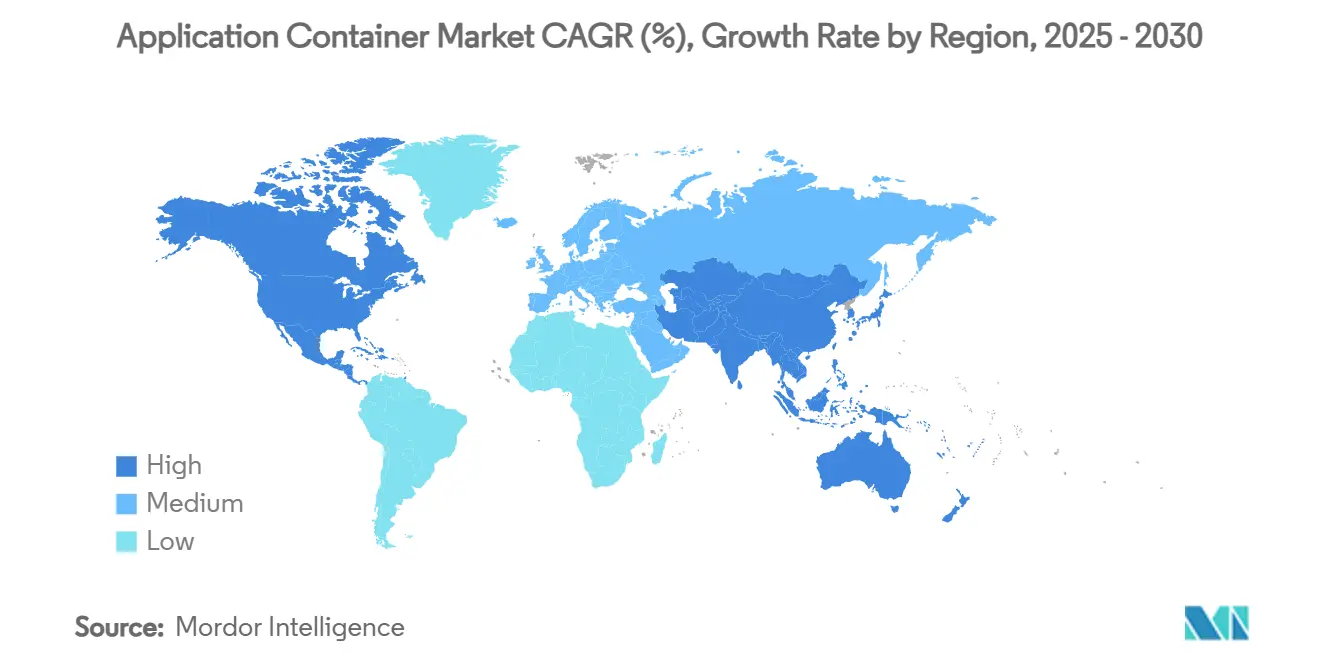
Competitive Landscape
Red Hat led with 47.8% revenue share and USD 460.7 million in 2020, translating early Docker partnerships into a thriving OpenShift subscription base. Mirantis followed at 15% after absorbing Docker Enterprise, while VMware captured 7.7% as vSphere users activated Tanzu clusters. SUSE, through its Rancher buyout, claimed 3.9%. This distribution places the top five vendors above the 70% threshold, signaling a moderately concentrated field where scale economies coexist with start-up disruption.
Strategic moves emphasize platform breadth and AI-optimized pipelines. NetApp integrated Astra Trident with OpenShift to furnish dynamic storage for containerized virtual machines[3]NetApp, “NetApp Collaborates with Red Hat,” netapp.com. Hitachi Vantara and Cisco co-engineered converged stacks that bundle Red Hat OpenShift, targeting uniform deployment across private and hybrid estates. Dell Technologies validated RHEL AI on PowerEdge servers with NVIDIA GPUs, sharpening its appeal to data-science teams. Meanwhile, a cadre of emergent specialists—covering cost-optimization, confidential computing and supply-chain attestation—keeps incumbents innovating at pace.
M&A prospects remain lively. Docker’s appointment of a new chief executive from Oracle signals potential readiness for acquisition by a hyperscaler looking to secure a 24-million-developer community. Market participants recognize that control of tooling ecosystems can tip platform preference at the design phase, a dynamic that will spark further consolidation and ecosystem alliances within the application container market.
Application Container Industry Leaders
-
Mirantis, Inc.
-
Docker, Inc.
-
Amazon Web Services, Inc.
-
Google, LLC
-
Microsoft Corporation
- *Disclaimer: Major Players sorted in no particular order
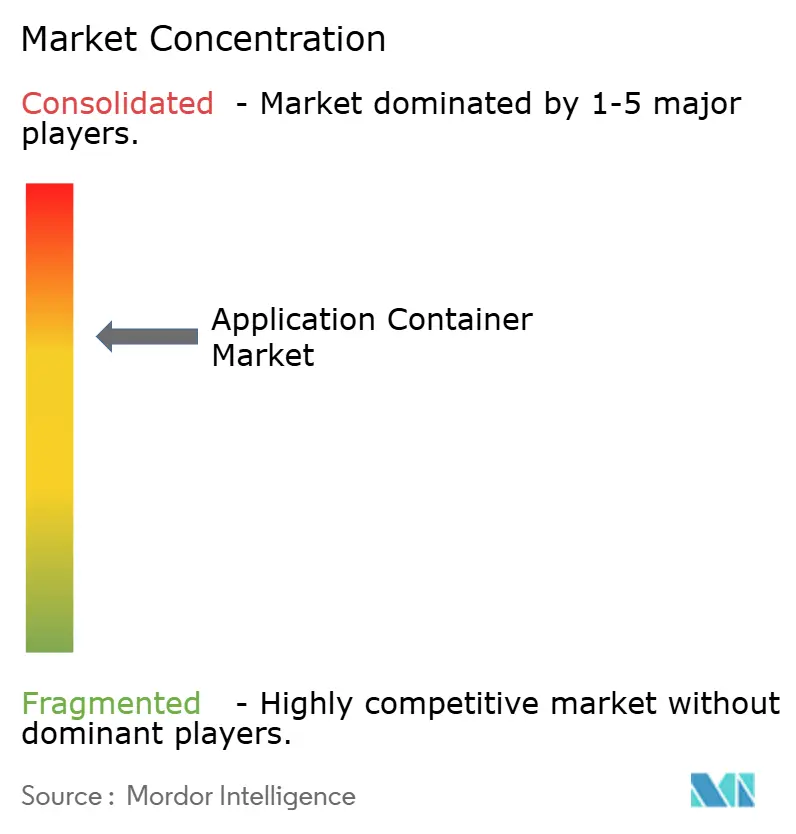
Recent Industry Developments
- February 2025: Hitachi Vantara and Cisco unveiled a converged infrastructure solution pre-configured for Red Hat OpenShift to accelerate AI-driven applications in hybrid-cloud settings.
- February 2025: Docker appointed Don Johnson as chief executive, prompting analyst speculation of an impending sale to a major cloud provider.
- November 2024: NetApp and Red Hat expanded collaboration, launching validated designs that merge OpenShift Virtualization with Cisco FlexPod for unified VM and container management.
- September 2024: Red Hat made Red Hat Enterprise Linux AI generally available, bundling the Granite LLM family for on-premises and cloud inference.
Global Application Container Market Report Scope
Application containers are standardized software units that bundle code with all its dependencies, ensuring swift and reliable application performance across diverse computing environments. Unlike traditional virtual machines, which require a full operating system for each application, application containers are resource-efficient, sharing resources more effectively. These software packages are self-sufficient, containing everything necessary for execution in any setting. By virtualizing the operating system, containers can operate seamlessly, whether on a developer's laptop or a public cloud.
The application container market is segmented by geography (North America [United States, Canada], Europe [United Kingdom, Germany, France, Spain, Rest of Europe], Asia-Pacific [China, India, Japan, Rest of Asia-Pacific], Latin America [Brazil, Argentina, Mexico, Rest of Latin America], Middle East and Africa [United Arab Emirates, Saudi Arabia, South Africa, Rest of Middle East and Africa]). The report offers market forecasts and size in value (USD) for all the above segments.
| Platform |
| Services |
| Public Cloud |
| Private Cloud |
| Hybrid and Multi-Cloud |
| Large Enterprises |
| Small and Medium Enterprises (SMEs) |
| IT and Telecom |
| BFSI |
| Healthcare |
| Retail and e-Commerce |
| Manufacturing |
| Government and Public Sector |
| Management and Orchestration |
| Monitoring |
| DevOps Tool-chain |
| Security |
| Networking |
| Storage |
| North America | United States | |
| Canada | ||
| Mexico | ||
| South America | Brazil | |
| Argentina | ||
| Colombia | ||
| Rest of South America | ||
| Europe | Germany | |
| United Kingdom | ||
| France | ||
| Italy | ||
| Spain | ||
| Russia | ||
| Netherlands | ||
| Rest of Europe | ||
| Asia-Pacific | China | |
| Japan | ||
| South Korea | ||
| India | ||
| Australia | ||
| Singapore | ||
| Rest of Asia-Pacific | ||
| Middle East and Africa | Middle East | Saudi Arabia |
| United Arab Emirates | ||
| Rest of Middle East | ||
| Africa | South Africa | |
| Egypt | ||
| Rest of Africa | ||
| By Component | Platform | ||
| Services | |||
| By Deployment Model | Public Cloud | ||
| Private Cloud | |||
| Hybrid and Multi-Cloud | |||
| By Organization Size | Large Enterprises | ||
| Small and Medium Enterprises (SMEs) | |||
| By Industry Vertical | IT and Telecom | ||
| BFSI | |||
| Healthcare | |||
| Retail and e-Commerce | |||
| Manufacturing | |||
| Government and Public Sector | |||
| By Container Use-Case Area | Management and Orchestration | ||
| Monitoring | |||
| DevOps Tool-chain | |||
| Security | |||
| Networking | |||
| Storage | |||
| By Geography | North America | United States | |
| Canada | |||
| Mexico | |||
| South America | Brazil | ||
| Argentina | |||
| Colombia | |||
| Rest of South America | |||
| Europe | Germany | ||
| United Kingdom | |||
| France | |||
| Italy | |||
| Spain | |||
| Russia | |||
| Netherlands | |||
| Rest of Europe | |||
| Asia-Pacific | China | ||
| Japan | |||
| South Korea | |||
| India | |||
| Australia | |||
| Singapore | |||
| Rest of Asia-Pacific | |||
| Middle East and Africa | Middle East | Saudi Arabia | |
| United Arab Emirates | |||
| Rest of Middle East | |||
| Africa | South Africa | ||
| Egypt | |||
| Rest of Africa | |||
Key Questions Answered in the Report
How fast is the application container market expected to grow through 2030?
It is forecast to expand from USD 10.27 billion in 2025 to USD 29.69 billion by 2030, reflecting a 23.64% CAGR.
Which deployment model is gaining the most momentum?
Hybrid and multi-cloud configurations are projected to grow at a 24.50% CAGR as firms balance performance, compliance and cost.
Why are services outpacing platform sales?
Organizations face skills gaps and complex migrations, so demand for consulting, managed operations and training is accelerating services revenue at 18.20% CAGR.
What makes healthcare the fastest-growing vertical?
Digital health programs and strict data-privacy regulations drive hospitals and med-tech firms toward containerized, scalable infrastructures, producing a 19.70% CAGR.
How severe are security risks associated with containers?
Average images contain 600+ vulnerabilities and major CVEs such as CVE-2024-0132 highlight the need for runtime protection and policy-as-code safeguards.
Which region will contribute most to future growth?
Asia-Pacific is estimated to lead incremental gains, advancing at 22.80% CAGR due to 5G rollouts, government cloud incentives and burgeoning digital-service demand.
Page last updated on:
